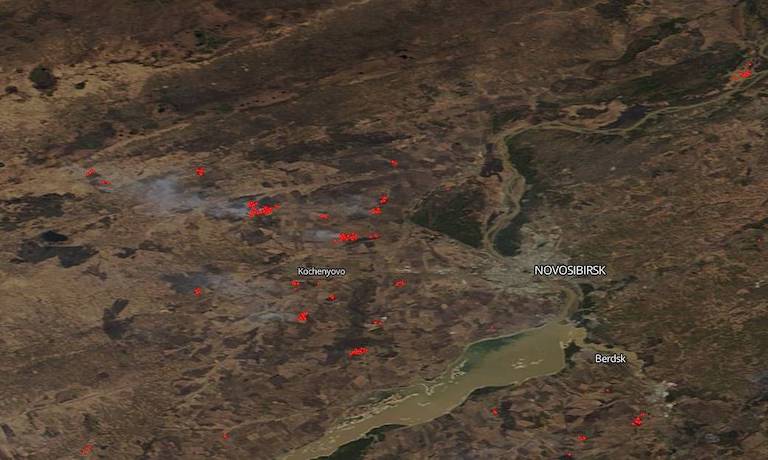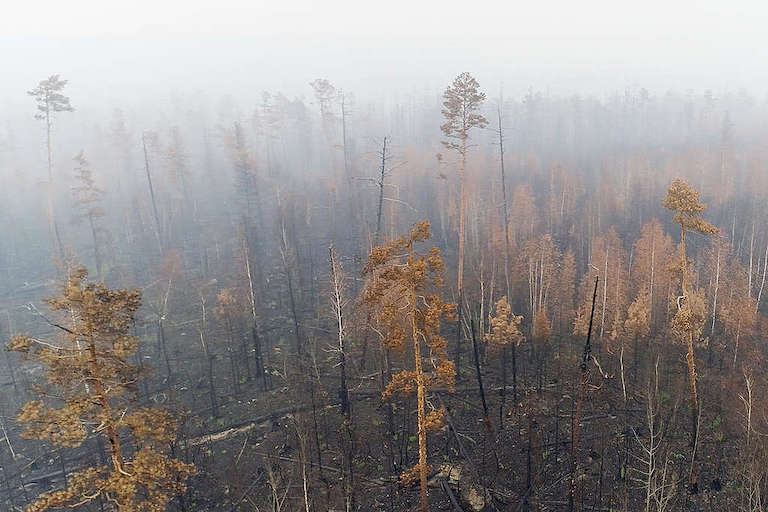- In April, many parts of Asia, including Siberia, experienced record heat, which led to wildfires in Russia’s northernmost region.
- Experts are concerned about the early start of the fire season in Siberia, especially after the mass devastation caused by the 2019 Siberian wildfires.
- The fires, which are likely fueled by climate change, could release more carbon dioxide into the air, which generates further warming, experts say.
- The more immediate threat is the health risk that the smoke from the fires pose to people, particularly when combined with the COVID-19 pandemic.
A few hundred miles south of the Arctic Circle, the small town of Boguchany in Siberia, Russia, had its hottest April on record. On April 25, the temperature soared to 31° Celsius (87.8° Fahrenheit), even though it should be much cooler at this time of the year.
Other parts of Siberia, and the greater continent of Asia, also experienced record heat. On April 27, the temperature in Tokmak, Kyrgyzstan, reached 35.1°C (95.2°F), while at Ayding Lake, China, the temperature peaked at 43.5°C (110.3°F). Over the past few months, Europe has also been dealing with abnormal heat during its warmest winter on record.

In Siberia, the high temperatures gave way to wildfires. On April 27, a satellite system operated by NASA captured an image of red flames and smoke blowing through at least nine regions near Kemerovo and Novosibirsk in Siberia.
Anton Beneslavskiy, a forest fire and climate emergency expert with Greenpeace International in Moscow, said it’s very concerning that fires were burning in Siberia this early in the season.
“This year’s fire season has started extremely early, and fires became intensive from the very beginning,” Beneslavskiy told Mongabay in an email. “That means a possible ‘long fire summer’ with a lot of forest destruction.”
Last year, fires swept through 15 million hectares (37 million acres) of forest in Siberia, although official numbers were underestimated, according to Greenpeace International. “It was definitely one of the most disastrous fire seasons,” Beneslavskiy said, adding that he didn’t see the fire situation improving in Siberia anytime soon.

The April fires are still burning as of today, Beneslavskiy said.
Kristina Dahl, senior climate scientist at the Union of Concerned Scientists, said she is also worried about these early fires in Siberia, especially in regard to the ramifications on human health.
“Right now, the health and well-being of people in the regions being affected needs to be the highest priority, particularly in light of the COVID-19 pandemic,” Dahl told Mongabay in an email. “Because both wildfires and COVID-19 affect respiratory systems, the combined threats could present serious risks to people in the region, especially if they have underlying health conditions.”
Climate change helped create the hot, dry conditions that fueled these Siberian fires, although it’s too early to ascertain its direct influence on the blazes, according to Dahl.

“While we’ll have to wait for scientific studies examining whether climate change made these fires more likely or influenced their extent, we know that climate change makes events like this more likely,” Dahl said. “So much has happened since the start of this year, but many will recall that Australia just suffered through an incredibly devastating wildfire season. Climate change was shown to have made those fires 30% more likely.”
The fires may be happening in remote regions of Siberia, but the entire world will be impacted, according to Dahl.
“The region is home to one of the world’s largest high-latitude forests and much of the region’s land is permafrost,” Dahl said. “Both forests and permafrost store enormous amounts of carbon. So when they burn or thaw, carbon dioxide is released into the atmosphere, which then causes further warming.
“While the immediate threats of these rising temperatures and large fires are to the people and ecosystems of Siberia, in the long term people and ecosystems worldwide are affected by what happens in Siberia,” she added.
Banner image caption: Russian firefighters battling a blaze in 2019. Image by Evgeny Titkov / Flickr.














